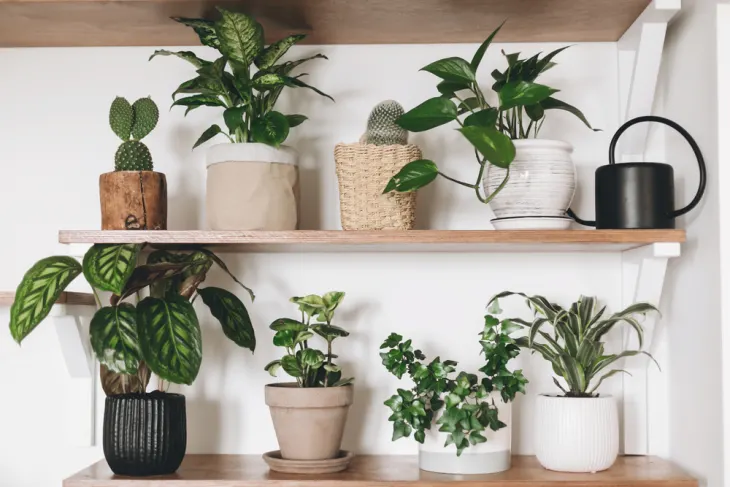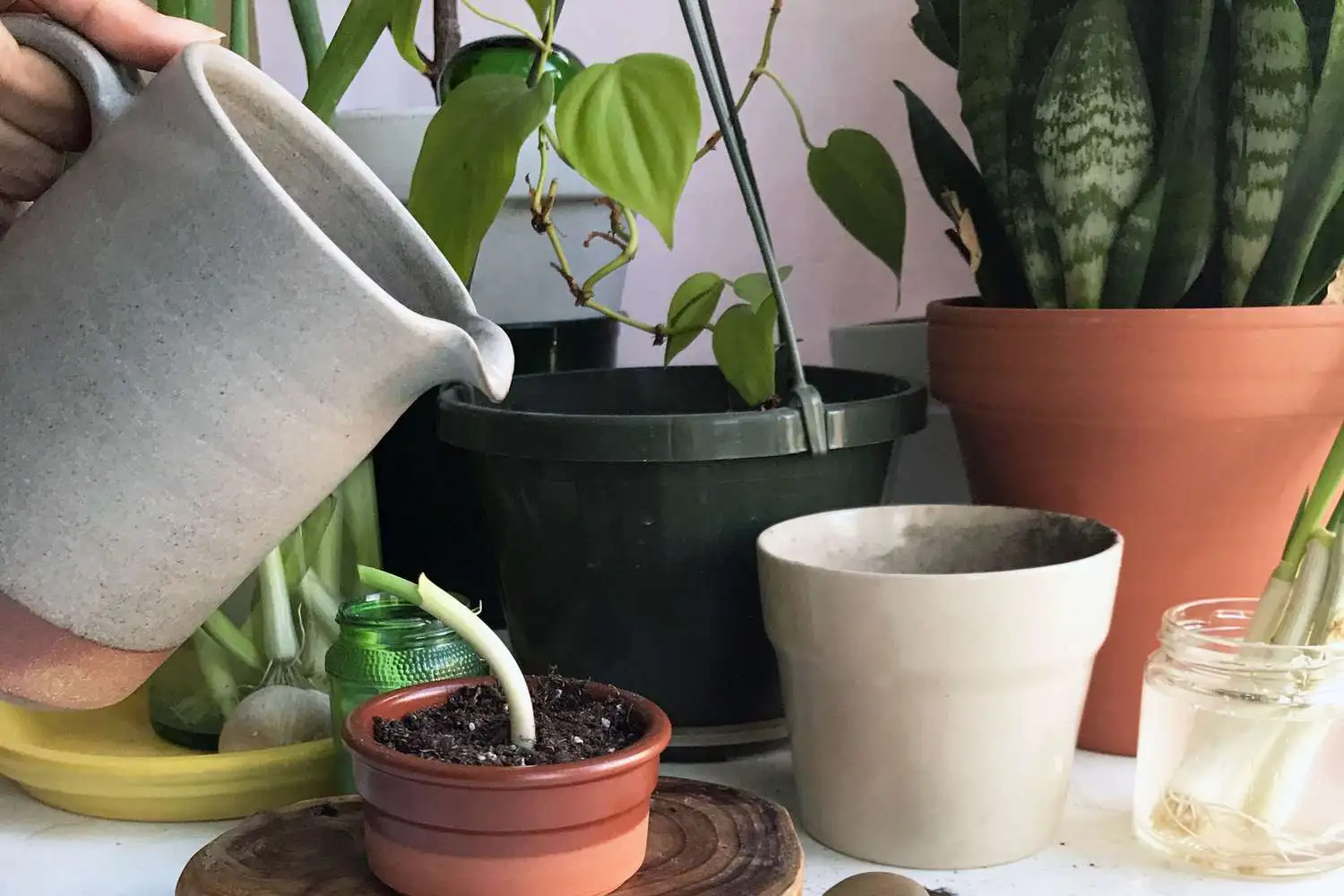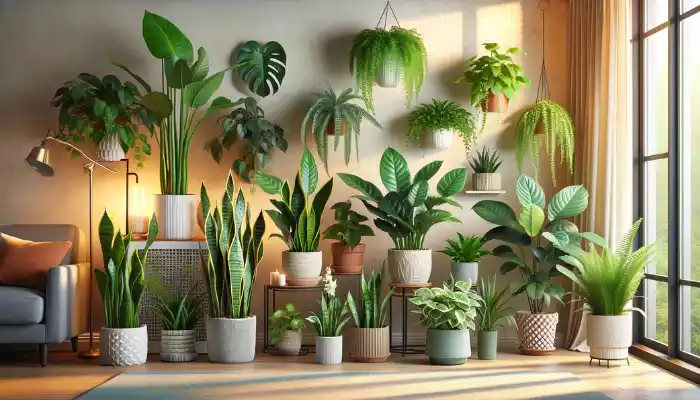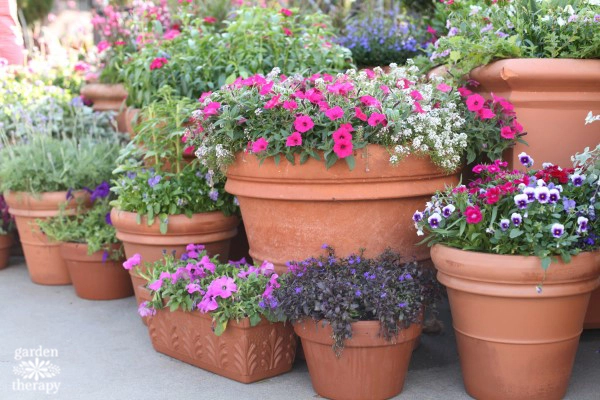Contents [show]
Introduction
Hey there, fellow apartment gardener!
Have you ever dreamed of transforming your tiny apartment into a lush, green oasis? Well, you’re not alone! With more and more people living in urban spaces, apartment gardening is becoming super popular. It’s not just about adding some greenery to your place – it’s also about bringing a slice of nature indoors, purifying the air, and even boosting your mood.
But here’s the deal: while having an indoor garden sounds awesome, it does come with its own set of challenges. One of the biggest hurdles you’ll face is potting your plants the right way. Yup, that’s right – how you pot your plants can make or break your indoor garden.
Now, you might be thinking, “Potting? How hard can that be?” Trust me, it’s not as straightforward as it sounds. Many of us, especially beginners, tend to make some common potting mistakes that can seriously mess with our plants’ health. But don’t worry, I’ve got your back! In this guide, we’re going to dive into the top potting mistakes to avoid, so you can keep your apartment garden thriving.
Why is proper potting so important, you ask? Well, imagine trying to grow in a space that’s too cramped or too big for you. Not fun, right? Plants are the same. They need just the right environment to spread their roots and grow strong. And that’s where proper potting comes into play. Getting it right means your plants will be happier, healthier, and way more likely to flourish.
So, let’s get into it! We’ll cover everything from picking the right pot size to avoiding overwatering (a super common mistake!) and making sure your plants have the perfect soil to grow in. Whether you’re a seasoned plant parent or just starting out, these tips will help you avoid the pitfalls and enjoy a thriving apartment garden.
Ready to turn your apartment into a green paradise? Let’s go!
Choosing the Wrong Pot Size
Alright, let’s start with one of the most common mistakes people make when potting their plants: picking the wrong pot size. You might not think much about it, but the size of your pot can seriously affect how well your plants grow.

Too Small Pots
Imagine trying to live in a shoebox – cramped and uncomfortable, right? Well, that’s how your plant feels in a pot that’s too small. When you choose a pot that’s too tiny, the roots don’t have enough room to spread out and grow. This leads to a couple of problems:
- Restricted Root Growth: Your plant’s roots get all tangled up and can’t expand properly. This is known as becoming root-bound.
- Frequent Watering Needs: With less soil to hold moisture, you’ll find yourself watering your plant a lot more often. And let’s be real, who has time for that?
When roots can’t grow freely, your plant’s overall growth gets stunted. It won’t be as lush and vibrant as you’d like.
Too Large Pots
On the flip side, you might think giving your plant a ton of space to grow is a good idea. But, surprise, surprise – a pot that’s too big can be just as bad. Here’s why:
- Excessive Soil Moisture: A big pot holds more soil, which means it also holds more water. If your plant’s roots are swimming in too much water, it can lead to root rot.
- Difficulty Managing Soil Moisture: It’s harder to keep track of how much water your plant really needs. You might end up overwatering without even realizing it.
So, what’s the right move? You want a pot that’s just the right size – not too big, not too small. A good rule of thumb is to choose a pot that’s about 1-2 inches larger in diameter than your plant’s current pot if you’re repotting. This gives the roots a little extra space to grow without overwhelming them with too much soil.
Remember, picking the right pot size is all about finding that sweet spot where your plant feels comfortable and can thrive. Get this part right, and you’re already on your way to a happy, healthy apartment garden!
Poor Drainage
Next up, let’s talk about something super important that often gets overlooked: drainage. Proper drainage is a game-changer for your plants. Without it, your plants can end up sitting in soggy soil, which they absolutely hate. Let’s dive into why good drainage is crucial and how to make sure your plants get what they need.

Importance of Drainage Holes
First things first, always check if your pot has drainage holes. These little holes at the bottom of your pot let excess water escape, preventing the soil from becoming waterlogged. Here’s why they’re so important:
- Prevents Waterlogging: Without drainage holes, water can accumulate at the bottom of the pot, creating a swampy environment. This can drown your plant’s roots, leading to root rot.
- Healthier Roots: Proper drainage helps roots breathe. Plants need oxygen just like we do, and good drainage ensures roots get the air they need to stay healthy.
Using Incorrect Potting Mix
Not all soil is created equal, and using the wrong type can mess with your plant’s drainage. Garden soil might work great outside, but indoor plants usually need something a bit different. Here’s what you need to know:
- Garden Soil vs. Potting Mix: Garden soil can be too heavy and compact for potted plants. It doesn’t drain well and can suffocate the roots. Potting mix, on the other hand, is designed to be light and airy, promoting better drainage and root health.
- Aeration and Drainage: A good potting mix will have ingredients like perlite, vermiculite, or peat moss, which help keep the soil light and well-aerated. This ensures water flows through the soil more freely, preventing waterlogging.
Using the right potting mix is like giving your plants the perfect home. It provides just the right balance of moisture and air, so your plants can thrive without any fuss.
Overwatering and Underwatering
Alright, let’s dive into one of the trickiest parts of plant care: watering. Getting the watering right is a bit of an art and science combined. Overwatering and underwatering are two of the most common mistakes that can really mess with your plant’s health. Let’s break it down so you can keep your green friends happy and hydrated just right.
Signs of Overwatering
Overwatering is like giving your plants too much of a good thing. Here’s what happens when you overdo it with the watering can:
- Yellowing Leaves: If you notice your plant’s leaves turning yellow, it could be a sign that you’re overwatering. The excess water can suffocate the roots, leading to poor nutrient absorption.
- Mushy Roots: Check the roots if you can. Mushy, brown roots are a clear indicator of root rot, which is caused by too much water and not enough oxygen.
When your plant’s roots are drowning, they can’t function properly. This can lead to all sorts of problems, from stunted growth to fungal infections.
Signs of Underwatering
On the flip side, underwatering can be just as harmful. Here are the telltale signs that your plant is thirsty:
- Wilting: If your plant looks droopy and sad, it’s probably not getting enough water. Wilting is a classic sign that your plant needs a drink.
- Dry Soil: Stick your finger about an inch into the soil. If it feels dry, your plant is likely underwatered. Dry, crumbly soil is a clear sign that it’s time to water.
When plants don’t get enough water, they can’t carry out essential processes like photosynthesis, which can lead to slow growth and even death.
Finding the Right Balance
So, how do you find that sweet spot between overwatering and underwatering? Here are some handy tips:
- Check Soil Moisture: Use your finger or a moisture meter to check the soil before watering. Only water if the top inch or so of the soil feels dry.
- Know Your Plant’s Needs: Different plants have different watering requirements. Succulents and cacti need less water, while tropical plants might need more frequent watering. Get to know what your specific plants need.
- Consistency is Key: Try to stick to a regular watering schedule, but be flexible based on your plant’s needs and the changing seasons.
Ignoring Plant-Specific Needs
Let’s talk about one of the most crucial aspects of plant care: understanding and meeting your plant’s specific needs. Every plant is unique and has its own preferences for light, temperature, and humidity. Ignoring these needs can lead to a lot of unhappy, struggling plants. Let’s break down what you need to know.

Understanding Light Requirements
Light is like food for plants. They need the right amount and type of light to thrive. Here’s what to keep in mind:
- Low Light Plants: These plants are perfect for spots that don’t get a lot of natural light. Think of plants like snake plants or pothos. They do well in dim corners and can tolerate low light levels.
- Medium Light Plants: These guys need a bit more light but not direct sunlight. Peace lilies and spider plants fall into this category. They like bright, indirect light.
- Bright Light Plants: These plants love lots of light, but not necessarily direct sunlight, which can scorch their leaves. Fiddle leaf figs and succulents thrive in bright, filtered light.
Not giving your plants the right type of light can cause poor growth, leggy stems, and discolored leaves. So, be sure to match your plant to the right spot in your home.
Temperature and Humidity Considerations
Just like us, plants have temperature and humidity preferences. Here’s what you need to know:
- Temperature: Most indoor plants are happy in the same temperature range that we are – generally between 65-75°F (18-24°C). Avoid placing plants near drafty windows, heaters, or air conditioners where temperatures can fluctuate wildly.
- Humidity: Many houseplants, especially tropical ones, love humidity. If your home is dry, especially in winter, your plants might suffer. Signs of low humidity include brown leaf tips and edges.
To keep your plants happy, you can use a humidifier, place plants on a tray with water and pebbles, or group plants together to create a microclimate.
Using the Wrong Soil Type
Alright, let’s dig into the dirt – literally! The type of soil you use for your plants is crucial. Not all soils are created equal, and using the wrong kind can spell disaster for your green friends. Here’s what you need to know to get your soil game on point.
Types of Potting Soil
Different plants have different soil needs, and using the right type of soil can make a huge difference. Here are the basics:
- Standard Potting Soil: This is your go-to for most indoor plants. It’s light, fluffy, and retains moisture well while also providing good drainage. Perfect for plants like pothos, spider plants, and peace lilies.
- Cactus Mix: Cacti and succulents need soil that drains super well. Cactus mix is sandy and doesn’t retain much water, which is ideal for these desert-loving plants.
- Orchid Mix: Orchids need special soil that mimics their natural environment. Orchid mix is chunky and airy, often made with bark and other coarse materials to provide excellent aeration.
Using the wrong soil type can lead to poor drainage, root rot, or insufficient nutrient uptake, leaving your plants struggling.
Amending Soil for Specific Plants
Sometimes, you need to tweak your soil to make it just right for your plant. Here’s how you can do it:
- Adding Perlite: Mixing perlite into your soil can improve drainage and aeration. It’s great for plants that don’t like to sit in wet soil.
- Adding Sand: For plants like succulents, adding a bit of sand to your potting mix can help create the fast-draining environment they love.
- Adding Peat Moss: Peat moss helps retain moisture and is good for plants that like their soil to stay damp, like ferns.
By amending your soil with these additives, you can create the perfect mix tailored to your plant’s needs.
Neglecting Fertilization
Let’s talk about plant food! Just like us, plants need the right nutrients to grow strong and healthy. Neglecting fertilization is a common mistake that can leave your plants looking sad and undernourished. Here’s everything you need to know to keep your plants well-fed and happy.
Importance of Fertilization
Fertilization is key to providing your plants with essential nutrients. Here’s why it’s so important:
- Nutrient Boost: Over time, the soil in your pots loses nutrients. Fertilizers replenish these essential nutrients, ensuring your plants get what they need to thrive.
- Promotes Growth: Proper fertilization helps plants grow faster and stronger. You’ll notice healthier leaves, more vibrant flowers, and overall better growth.
- Disease Resistance: Well-nourished plants are more resistant to diseases and pests. Fertilization helps build a strong immune system for your plants.
Without regular fertilization, your plants can suffer from nutrient deficiencies, leading to slow growth and a lackluster appearance.
Choosing the Right Fertilizer
Not all fertilizers are the same. Here’s how to pick the right one for your plants:
- Organic Fertilizers: Made from natural materials, organic fertilizers release nutrients slowly and improve soil health over time. Examples include compost, worm castings, and fish emulsion.
- Synthetic Fertilizers: These are chemically formulated and provide a quick nutrient boost. They come in various forms, such as liquid, granular, or slow-release pellets. Synthetic fertilizers are easy to use and provide immediate results.
- Balanced Fertilizers: Look for a balanced fertilizer with equal parts nitrogen (N), phosphorus (P), and potassium (K) – often labeled as 10-10-10 or 20-20-20. These are great for overall plant health.
- Specialty Fertilizers: Some plants have specific nutrient needs. For example, flowering plants benefit from fertilizers higher in phosphorus, while leafy plants thrive with higher nitrogen content.
How to Fertilize Correctly
Now that you’ve got the right fertilizer, here’s how to use it properly:
- Follow the Instructions: Always follow the instructions on the fertilizer package. Over-fertilizing can be just as harmful as under-fertilizing.
- Regular Schedule: Fertilize your plants regularly during the growing season (spring and summer). Cut back during the fall and winter when plant growth slows down.
- Water Before Fertilizing: Make sure the soil is moist before applying fertilizer. This helps prevent root burn and ensures even distribution of nutrients.
- Gradual Feeding: Start with a diluted fertilizer solution and gradually increase the strength as your plants adjust. This is especially important for young or sensitive plants.
Not Repotting When Necessary
Let’s chat about repotting – an essential but often overlooked part of plant care. Just like us, plants need room to grow, and sometimes their current pot just doesn’t cut it anymore. Neglecting to repot your plants can lead to all sorts of problems, but don’t worry, I’m here to guide you through it!
Signs That Plants Need Repotting
So how do you know when it’s time to give your plant a new home? Look out for these signs:
- Roots Out of Drainage Holes: If you see roots poking out of the bottom of the pot, your plant is definitely root-bound and needs more space.
- Soil Dries Out Too Quickly: If the soil seems to dry out super fast, it could be because the plant’s roots have filled up the pot and there’s not enough soil left to retain moisture.
- Stunted Growth: When a plant’s growth slows down or it stops growing altogether, it might be struggling with limited root space.
- Crowded Roots: If you gently pull the plant out of the pot and find the roots all circling around the root ball, it’s a clear sign that it needs more room to stretch out.
Repotting is like upgrading your plant’s living conditions. It gives them the space they need to spread their roots and continue growing strong.
How to Repot Properly
Repotting doesn’t have to be stressful. Here’s a simple step-by-step guide to make it a smooth process:
- Choose the Right Time: Spring is the best time to repot because plants are coming out of their dormant period and are ready to grow. Avoid repotting during the winter when most plants are resting.
- Pick a Slightly Larger Pot: When selecting a new pot, choose one that’s 1-2 inches larger in diameter than the current pot. Too big a pot can lead to overwatering issues.
- Prepare the New Pot: Add a layer of fresh potting mix to the bottom of the new pot. This helps provide a good base for your plant’s roots.
- Remove the Plant Carefully: Gently take the plant out of its current pot. You might need to tap the sides or use a tool to loosen it if it’s stuck.
- Loosen the Roots: If the roots are tightly bound, gently tease them apart to encourage them to grow outward.
- Add Fresh Soil: Place the plant in the new pot and fill in with fresh potting mix. Make sure the plant is at the same level it was in the old pot.
- Water Well: After repotting, give your plant a good watering to help settle the soil and reduce transplant shock.
Aftercare for Repotted Plants
After repotting, your plant might need a little extra TLC:
- Monitor Watering: Keep an eye on soil moisture as the plant adjusts to its new pot. The soil might dry out faster or slower than before.
- Avoid Direct Sunlight: For a few weeks, place the repotted plant in a spot with indirect light to help it acclimate.
- Fertilize Sparingly: Wait a few weeks before fertilizing to avoid stressing the plant. It will need some time to settle into its new pot.
Conclusion
And there you have it – the top potting mistakes to avoid in your apartment garden! By now, you’ve learned about the importance of choosing the right pot size, ensuring proper drainage, getting your watering just right, understanding plant-specific needs, using the right soil, and not forgetting to repot when necessary.
Recap of Common Potting Mistakes
Let’s quickly recap the common pitfalls to avoid:
- Choosing the Wrong Pot Size: Make sure your pot isn’t too big or too small. Finding the right size helps your plant’s roots grow properly.
- Poor Drainage: Ensure your pots have drainage holes and use the right potting mix to prevent waterlogging and root rot.
- Overwatering and Underwatering: Strike a balance with watering – not too much and not too little. Check your soil moisture regularly.
- Ignoring Plant-Specific Needs: Understand your plant’s requirements for light, temperature, and humidity to keep them thriving.
- Using the Wrong Soil Type: Use the right soil mix for your plant type to ensure proper drainage and nutrient availability.
- Neglecting Fertilization: Don’t skip on fertilizing. Provide your plants with the nutrients they need to grow strong.
- Not Repotting When Necessary: Watch for signs that your plant needs a larger pot and repot it to give its roots more space to grow.
Encouragement to Apply Tips
Avoiding these common mistakes will help you create a thriving indoor garden that’s the envy of your friends and family. Don’t get discouraged if things don’t go perfectly right away. Gardening is a learning process, and each plant you care for teaches you something new.
Remember, a little extra care and attention can make a big difference. Your plants will thank you with vibrant growth and beautiful greenery that brightens up your apartment.
Additional Resources
If you’re hungry for more plant care tips or want to dive deeper into specific topics, check out gardening blogs, join online plant communities, or watch videos from experienced plant enthusiasts. There’s a whole world of knowledge out there to help you become a plant pro!
So, roll up your sleeves, get those hands dirty, and enjoy the rewarding experience of nurturing your very own indoor garden. Happy planting!







